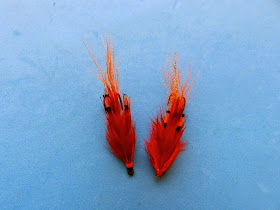 |
| An Introduction to Tube Flies: Fishing and Tying |
News
The first bit of news is that the Fly Shop is sold out of just about everything, save for a few odd flies. I tie up a small inventory during the summer, mainly for sale in the fall. I'm happy that sales have been good, though it's hard to predict which flies will sell the most before the season starts. There was a lot of demand Ally's Shrimp this fall. I ran out quickly and had to tie a lot during the fishing season. That's a "good problem," as far as I'm concerned! Anyhow, I took down all the PayPal "add to cart" buttons until I can restock. I plan on starting tying earlier this year to boost inventory for next fall. In the meantime, feel free to contact me if there are any flies you need for winter, spring, or summer. They can be flies listed on the Fly Shop page, or something else you might have seen here or elsewhere. Often times, I am contacted to tie flies a shortly before an angler's salmon fishing trip. If possible, a little more lead time would help since I don't tie full time. Spring/early summer and fall are usually my busiest seasons in the music business (see below). I have plenty of time for custom orders this winter, however. Give me a holler now if you need flies for the upcoming Canadian or European Atlantic salmon season, or for any other fishery.
A new addition to my website is the Presentations page. Information and summaries of each presentation are available on this page. My "Traditional Techniques for Broodstock Atlantic Salmon" has been well very received at local fishing and conservation club meetings. I'm happy to offer a new presentation, "An Introduction to Tube Flies: Fishing and Tying," which will be debuting next month (see below). I've notice a local reluctance to try tube flies, even when I've given them out for free. This presentation should help clear up any confusion as to how to fish and/or tie effective tube patterns for all species.
I decided to take a break from tying anything in January and thoroughly clean my tying room (I cheated a little). It was too cluttered for too long and I was beginning to get annoyed with it. I finally took the time to razor the pile of trashed flies that had been accumulating for several years. I'm most of the way through the cleanup and reorganization job now and it's starting to look a lot better. I'll be ready to hit the ground running come February.
I tend to ignore the gallery section of the website until I have make major changes. I added a few new fishing and tying pics. I will add more to the Fishing Gallery and Fly Gallery throughout the winter. Check back every now and then!
Events
I have a couple of presentations scheduled this winter. It would be great to see some of you there! Here are the details:
“Introduction to Tube Flies - Fishing & Tying”
February 17, 2015
7:00pm
Port 5 Naval Veterans
69 Brewster St.
Bridgeport, CT 06605
“Traditional Techniques for Broodstock Atlantic Salmon”
March 11, 2015
7:00pm
Michael’s at the Grove
42 Vail Rd.
Bethel, CT 06801
-------------------------------------------------------------------
.jpg) |
| Litchfield Jazz Festival 2013 (photo by H. Judd) |
By night, I am a professional jazz musician. I mention it here on occasion, but I thought I'd plug a good gig I have coming up at the end of this month.
Ben Bilello, Laurence Hobgood & Henry Lugo
January 30, 2015
8:00pm-11:00pm
$10 cover
$10 cover
56 Orange St.
New Haven, CT 06510
The 9th Note is a great new club and you should definitely check it out. The trio with Laurence and Henry is very dynamic. I love working with both of those guys. Laurence is a fellow fly fisherman, so feel free to talk fishing with him, too.
As a side note, I am giving a free brush playing clinic before the show. It will run from 6:00pm to 7:00pm. I'll take a short break, we'll run a brief soundcheck, then start the show at 8:00. Check benbilello.com or the9thnote.com for more information. This will be a very exciting show...one not to miss!













